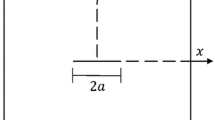Abstract
In order to compare the calculation methods of stress intensity factors and crack propagation criterion, and to find the best method to calculate stress intensity factors and crack propagation criterion. The FRANC3D software was used to calculate and analyze the specimen with a center crack, the specimen with a single side crack, the specimen with bilateral cracks and the cylindrical specimen with a deep buried elliptical crack. The calculation methods of three stress intensity factors including displacement correlation method, virtual crack closure integral method, and M-Integral method were compared. The relative advantages and disadvantages of two crack propagation criterions including maximum circumferential stress criterion and maximum strain energy release rate criterion were studied. The results show that in the calculation methods of three stress intensity factors, the accuracy of the M-Integral method and the virtual crack closure integral method is better, and the displacement correlation method is poorer. Between the two criterions of crack propagation, maximum circumferential stress criterion is superior to maximum strain energy release rate criterion.
Access this chapter
Tax calculation will be finalised at checkout
Purchases are for personal use only
Similar content being viewed by others
References
Cornell Fracture Group: Franc3D User’s Guide. Version 7.1 (2017)
Ronald, K.: The virtual crack closure technique: history, approach and applications. ICASE Report No. 2002-10. NASA Langley Research Center, Hampton, Virginia (2002)
Perez, N.: Fracture Mechanics. Kluwer Academic Publishers, Dordrecht (2004)
Sih, G.C., Paris, P.C., Erdogan, F.: Crack-tip, stress-intensity factors for plate extension and plate bending problems. ASME J. Appl. Mech. 9, 306–312 (1962)
Palaniswamy, K.: Crack propagation under general in-plane loading. Ph.D. thesis, California Institute of Technology, USA (1972)
Sih, G.C.: Strain energy density factor applied to mixed mode crack problem. Int. J. Fract. 10(3), 305–321 (1974)
Zhongwei, Y., Yunwen, F., et al.: A method for calculating stress intensity factor of crack by stress field strength. Mech. Strength 31(1), 117–121 (2009)
Alshoaibi, A.M., Ariffin, A.K.: Finite element simulation of stress intensity factors in elastic-plastic crack growth. J. Zhejiang Univ. (Sci. A) 7(8), 1336–1342 (2006)
Zhao, Y., Xu, S.: Minimum J2 criterion for brittle fracture of type I - II composite crack. Eng. Mech. 19(4), 94–98 (2002)
Xu, S., Reinhardt, H.W.: Determination of double-K criterion for crack propagation in quasi-brittle fracture, Part I: experimental investigation of crack propagation. Int. J. Fract. 98(2), 111–149 (1999)
China Institute of Aeronautical Research: Stress intensity factor manual. Science Press (1981)
Acknowledgements
This paper is written with support of National Natural Science Foundation of China (Grant No. 51578127&51778122), and Key research and development project of Jiangsu Province (Grant No. BE2017717).
Author information
Authors and Affiliations
Corresponding author
Editor information
Editors and Affiliations
Rights and permissions
Copyright information
© 2019 Springer Nature Singapore Pte Ltd.
About this paper
Cite this paper
Qing, C., Chengwen, Z., **aohu, J. (2019). Comparative Research on Calculation Methods of Stress Intensity Factors and Crack Propagation Criterion. In: Abdel Wahab, M. (eds) Proceedings of the 7th International Conference on Fracture Fatigue and Wear. FFW 2018. Lecture Notes in Mechanical Engineering. Springer, Singapore. https://doi.org/10.1007/978-981-13-0411-8_20
Download citation
DOI: https://doi.org/10.1007/978-981-13-0411-8_20
Published:
Publisher Name: Springer, Singapore
Print ISBN: 978-981-13-0410-1
Online ISBN: 978-981-13-0411-8
eBook Packages: EngineeringEngineering (R0)




